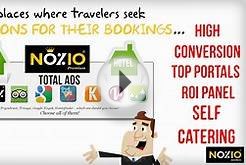In this post Daniel Scocco answers to another question on the Problogger Question Box (and a question that I get asked a lot). Brian Auer asks:
What about [direct advertising] pricing? Are there any good ballpark price structures? What do we base rates on?
As soon as a blogger decides to play with direct advertising, the question of “how much to charge” emerges. If you charge too much, you might end up with no advertisers at all. If you charge too little, on the other hand, you will be leaving money on the table.
Unfortunately, as Brian wonders, there are no standard pricing structures across the Internet. You will need to take a look around, do some research, and experiment on your own site to find the rates that will maximize your revenues.
That being said, that are some methods that you can use to draw an initial price tag, and some specific places where you can look to cross check the numbers. Below we will cover them.
Defining the metrics: The CPM
Notice that talking about advertising prices in absolute values is useless.
Suppose there are two blogs. One charges $500 monthly for a 125×125 banner spot above the fold, while the other charges $1, 000 for a similar spot. Could we say that the first blog offers a much better deal for advertisers?
Obviously not, because the value that the advertiser will get for its money depends on a myriad of factors, above all the traffic that each of the two blogs receives monthly.
If the first blog generates 100, 000 monthly page views while the second generates 500, 000 monthly page views, an advertiser would be better off by purchasing the advertising space of the second blog for $1, 000.
As you can see, the answer to our question comes from a very simple ratio: cost of the advertising space divided by the traffic that the ad will receive.
Several metrics could be used to define traffic, from unique visitors to visits and page views. Most publishers tend to use page views though. Moreover, it is a common practice to measure page views by the thousands, so one should talk about cost per 1, 000 page views or impressions. CPM is the term for that, and it stands for Cost Per Mille (Mille being the Latin word for 1, 000).
Just to conclude our example, if you do a small calculation you can see that the first blog has a $5 CPM while the second one has a $2 CPM.
Now, we are not suggesting that you should tie your ad rates to the number of monthly impressions of your blog. Offering a flat monthly rate to advertisers is usually the best (and simpler) way to go. Just keep the CPM numbers in mind because they will enable you to compare your prices with those of other bloggers.
What do other bloggers charge?
Like it or not, the Internet behaves like a giant market place, and all websites are subject to the laws of supply and demand. In other words, if you set a price that is significantly higher than the one used by other blogs on your niche, the advertisers will go somewhere else.
The first thing you should do, therefore, is to take a look on blogs that sell advertising space to evaluate what rates they are asking.
The format of the ad (e.g., 468×60, 120×600, 125×125) and the position (e.g., header, sidebar, footer, blended with content) are factors that will directly influence the final price, so in order to be consistent through out your research you should pick a format and position that is popular.
Let’s see what popular blogs on the online marketing sphere are charging, for instance. If you visit the page of Copyblogger, you will find that the blog generates over 1, 000, 000 monthly page views, and a 125×125 spot on the sidebar costs $1, 500. Divide $1, 500 by 1, 000 (remember that 1, 000, 000 is equal to 1, 000 times 1, 000 page views) and you get a CPM of $1, 5.
Similarly, if you visit JohnChow you will find that the 125×125 button add costs $500 monthly, and the blog generates 300, 000 page views. Again just do $500 divided by 300 and you get a CPM of $1, 66.
As you can see a CPM of $1, 5 for the 125×125 buttons is a good average. Even TechCrunch charges a similar rate ($10, 000 for 6, 5 million page views monthly, converting to a CPM of $1, 53), so let’s keep that number as a starting point.
Adapting to your own situation
All the blogs mentioned are viewed as authorities on their niche, which affects how much advertisers are willing to pay to get exposed to their audiences. If your blog is new or if you are just beginning to experiment with direct advertising, therefore, you probably should start with a lower CPM.
Start asking a $0, 5 CPM, for example, and as your blog grows and more advertisers come along you can gradually raise it. If you have a blog generating 100, 000 monthly page views this would translate into $50 monthly for each 125×125 button placed on your sidebar.
If you are going to use other ad formats or position the ads on other locations of your website just estimate how these factors will affect the traffic that an advertiser will end up getting. Placing a 300×250 banner on the sidebar, for instance, is similar to having 4 125×125 ads, so you could charge 4 times the price of the 125×125 ad ($200 monthly if your blog generates 100, 000 impressions, converting to a $2 CPM).
Similarly, increase the CPM if the ad is on the header or blended with the content, and decrease it if the ad will be displayed below the fold or on the footer.
Keep in mind that you should consider real page views for these evaluations. Most web stats programs and software tend to over estimate the traffic on your site. Google Analytics is usually the most reliable one.
Cross checking the numbers and experimenting
In order to cross check the numbers with an external source you could join an advertising network (either CPC based like Google Adsense or CPM based) and use it on the spots where you plan to sell direct advertising.
If you are planning to sell a 300×250 banner spot below your posts, for instance, you could firstly put a Google AdSense unit there and measure the CPM that it will give. Most direct advertising deals should bring you more money that what advertising networks do, mainly because you are cutting out the commissions and negotiating directly with the advertisers.
Finally, remember to experiment endlessly and draw your own conclusions. What works for one blog may not work for another, and vice-versa.
Over to you
Defining optimal advertising rates is a tricky business, and I recognize that the methods and strategies described above might not work for everyone.










